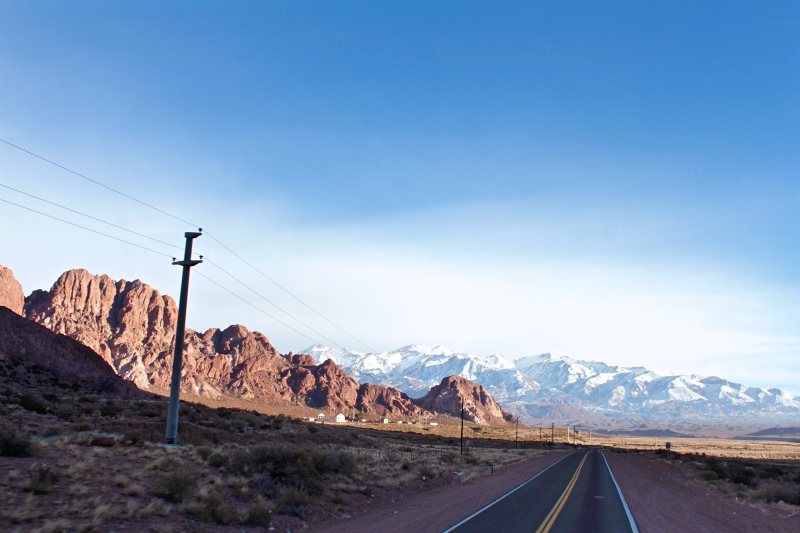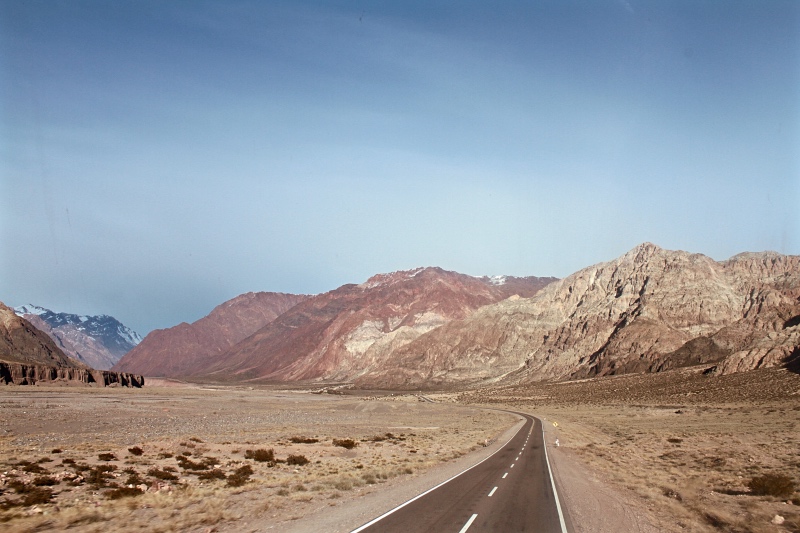Mendoza is Argentina’s premiere wine region, and as such, there was no way that we were going to miss a short stopover to indulge in one of our favourite pastimes. Our flight back home departed from Santiago, so we knew that we had to make our way back to Chile at some point. Mendoza is located at the foot of the Andean Mountains and sits virtually parallel to Santiago. It was the perfect place to relax and unwind before making our way back to Chile by bus, through some of the most incredible scenery we have ever seen.
Mendoza itself isn’t the most spectacular town, and to be honest, after the beautiful architecture and vibrant atmosphere of Buenos Aires, Mendoza seemed dull and unattractive. We later learned that it had been levelled by a devastating earthquake in 1861, which destroyed the colonial architecture that we had expected to see. The town was subsequently rebuilt utilising sturdy construction techniques aimed at minimising the damage in possible future earthquakes – this explains why the buildings are uniformly squat and plain and why the extra-wide streets are organised around large, flat squares. It might not be an architectural destination, but what Mendoza lacks in beauty it makes up for in multiple other ways. The proximity of the Andean mountains and the surrounding desert and valleys lends itself to adventure sports (such as rafting, skiing, mountain climbing, fishing), and the presence of so many quality wineries in the area attracts wine connoisseurs who must be catered to with excellent restaurants, spas, hotels and luxury retail outlets.
With a late arrival, early departure and only a single full day up our sleeves, we were forced to focus our activities in Mendoza. We were there for the wine, number one, but after a whirlwind two weeks on the road we also needed a rest. We took care of that with an indulgent massage in the hotel’s chilly spa, ate a hurried and forgettable lunch, then joined an afternoon wine tour. Our first stop was the bodega (winery) Cavas de Weinert situated south of Mendoza in Luján de Cuyo. Paired with a guide who spoke English, we were treated to a tour of the atmospheric winery and underground cellar, which was originally built in 1890. Cavas de Weinert has preserved the beautiful architecture and conserved many old methods of wine-making such as hand-picking the grapes and ageing the wines in huge casks as opposed to smaller barrels. At the requisite tasting it was immediately obvious that we were sampling very special, complexly layered, old world wines. We tasted three vintages of their signature blend of Malbec, Cabernet Sauvignon and Merlot, marvelling at the intensification of mellow, Christmas-pudding-like flavours as the wine had aged. A bottle of our favourite, the gorgeous 2006 vintage, cost a mere $300 ARD (approximately $25 AUD) and subsequently found its way home, buried deep in our bags.
We moved on to a family-run olive oil business, Pasrai, in Maipú where we toured the factory and tasted the delicious products. My favourite was an unfiltered extra virgin oil where the presence of finely ground olive puree gave a cloudy appearance and concentrated grassy flavours. After a pleasant hour, we then drove to another bodega in Maipú, Vistandes; this time a relatively young winery that was established in 2006. The modern facilities, stainless steel tanks and designer lighting were in stark contrast to the old world charm of Cavas de Weinert, but it was still an atmospheric place. As the sun set we tasted wines in front of towering glass windows that looked west, over the vines towards the Andes. The wines at Vistandes were pleasant, but decidedly underwhelming given our earlier, far more memorable experience.
The next morning we rose brutally early, ate a hurried breakfast and made our way in the dark to the local bus station. We departed at 7am to begin our nine-hour journey over the Andes and back to Chile. We had pre-booked our tickets, choosing seats right at the front on the upper deck in anticipation of the stunning mountain scenery. We needn’t have worried; the bus had a total of 14 passengers and most of them promptly fell asleep so before long, we spread ourselves right across the four front seats, enjoying the panoramic view as we sped along the highway. As the elevation began to rise the windows misted up which caused much frustration. We rubbed and tissued and wiped and cursed, struggling for quite some time to get any decent photos – even so, I quite like the painterly effect that resulted in some of the shots:
The bus wove along the narrow road, through tunnels, over bridges, climbing higher and higher towards the snow-capped mountains in the distance. The windows stopped misting as the sun burned off wisps of cloud, revealing a brilliant blue sky. The Argentinian side of the Andes is much drier than the Chilean because the mountains form an effective barrier to the precipitation that sweeps in from the Pacific Ocean. The arid plains and red rock formations made for spectacular viewing, and when we weren’t snapping cameras, we were simply absorbing the incredible view. Our fellow passengers had clearly seen it all before as they continued to snore in the background, or pass comments about the Spanish film playing on a tiny television mounted above our heads.
After several hours of driving we suddenly hit snow. The bus passed through several tiny settlements, including one which was clearly a local army base with troops training in the dense snow. The traffic had been steady the whole way and it gradually increased as we neared the border. Although the road was narrow and conditions were harsh, it was clearly an important distribution route between Argentina and Chile.
When we finally arrived at the border, Paso Internacional Los Libertadores, we were initially confronted with a long line of backed up traffic, but our driver soon pulled out to the right and drove past truck after truck loaded with cargo. Arriving at the customs station we then waited for nearly two hours before beginning the relatively quick process of getting our passports stamped. There was so much waiting around that we snuck off to use the bathroom at what turned out to be a critical moment. Despite the frontier feel of the place, the staff took their roles very seriously indeed. While Colin was still occupied, our busload of passengers were shouted at to form a line in front of our bags. Stalking along the row, our driver demanded to know where my compañero (companion) was, and my response, baños (bathroom), was met with a torrent of Latin fury. No-one spoke any English and I was very relieved when Colin returned. As soon as he joined the line someone barked an order and we were marched past three guards and sniffed at by large Alsatians, while our bags were sent along a creaking conveyor belt to be x-rayed. After this frenzy, we re-boarded the bus, drove a short distance and passed into Chile.
After the long and gentle ascent from Mendoza (to a peak of 3, 207m/10, 521 ft above sea level) the descent into Chile was incredibly fast thanks to a stretch of road known as Los Caracoles (The Snails). This extremely steep road includes a total of 28 hairpin turns (each numbered Curva 1-28). Each time we swung around a curve we felt suspended in the air; an excitingly unnerving effect of our seats at the front. In the icy conditions, in the proximity of heavily loaded trucks and lacking any form of guardrail or barriers, it must have taken intense concentration for the driver to descend. Fortunately we were soon driving past an aqua lake and then down through the familiar cactus-dotted valleys that we had seen on our previous trip into the Andes. Some of the passengers got off the bus to travel south to Santiago, but we continued through the town of Los Andes and on towards the coast. After a total of nine hours travelling we arrived in Valparaíso, found our hotel and headed out for steaming bowls of seafood soup. We slept so well that night.
















Pingback: Travel Journal | Valparaíso, Chile | Chez Moi
Beautiful tale. I live the photos of the region!
A wonderful travel log; I was there with you and stunning photos – thanks for sharing 🙂
Thanks Lucy 😊 it feels like so long ago now so it was lovely to revisit the photos and memories and relive it again.
Absolutely stunning pics! I am kind of cracking up bec. bodega in the US means something completely different – Kat
I just had to go and google it as I was thinking that it might be code for “brothel” in the US! So I’m guessing that you’re more familiar with it being used to describe a convenience store? Or…maybe it is a brothel?! Let me know, I’m curious! Happy Easter Kat 😊
This is seriously making me reconsider going to Europe and instead try to go to Argentina this year, but maybe I should wait until it’s summer/fall there to avoid any snow. 🙂 This trip looks like it was amaaaaazing!
It was exactly that Elizabeth! My only regret is that we had so little time – three weeks was enough for a quick taste and that’s it. Next time we’ll allow more time and get out into the stunning rural areas more. It’s such a beautiful country (Chile too).
Wow! This is not what I expected it to look like! My favorites are the red sofas and the switchbacks – great pics! Enjoy the adventure!
Thanks I’m glad that you enjoyed the photos! Our trip was a while ago though, in June and July last year. Just reminiscing…sadly. Your blog looks very interesting BTW, great concept!
I love this Chez! We must get together and share some of these stories over a wine or two. I will seek your advice on any trips I have to Sth America. Great pics!
Thanks Urlys, yes a catch up to discuss travel and drink wine is definitely in order! Hope that you’re well xx
A couple of years ago we travelled back and forth between Chile and Argentina. The border crossing was always a long wait and strict controls, especially coming in to Chile.
There were quite a few tourists making the trip in cars. If I ever get the chance to go again it would be great to do it by car. There were so many times when I wanted to stop and look around the incredible landscape. Why did you go back and forth so often? Were you working in the area at the time?
Spectacular photos. I love the one of the hairpin curves.
I love it too. I think that the contrast between the dark road and white snow makes it especially dramatic. I’m glad we went there in winter. I’m also glad that I didn’t have to be the one to drive us down that mountain! Nerves of steel required.